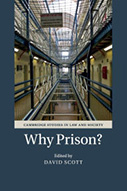Why Prison?

Editor: David Scott
Publisher: Cambridge, UK; New York: Cambridge University Press, 2013. 408p.
Reviewer: H. Bennett Wilcox III | May 2017
Most contemporary scholars writing on the subject of punishment would agree that there are myriad motivations, justifications, and excuses regarding why people commit the criminal offenses that they do. Indeed, the existing body of literature on theories of crime causation is ever-expanding and embraces explanations centered on a wide variety of variables, dynamics, and institutional relationships including: biological predispositions, psychological personality traits, social learning, cognitive thinking, geographical location and the ecology of place, relative deprivation and the strain of capitalist society, as well as political conflict and much more. However, when focus shifts to the choice of one form of punishment over another, or the appropriateness of a particular modality to correct a specific type of offending, the alternative responses are reduced to but a few. As a result, criminal justice systems across the planet have adopted a more or less “one-size-fits-all” approach in the form of punitive carceral systems. Such systems seek to repress the behaviors of these law violators via a narrow range of punishments built primarily on archaic understandings of retribution, incapacitation, deterrence and segregation while ignoring restorative and peacemaking modalities that are seen as more efficacious by many criminologists.
If we accept that crimes are committed for varying reasons, then might it not also hold true that punishment, to be effective, should involve approaches that are proportional to and as varied as the offenses committed? The idea that the expansion of modern incarcerative systems (jail and prison) worldwide, as opposed to community-based forms of punishment, for example, suggests that this is not necessarily a widely shared belief. These systems are derided regularly as failed social interventions that are routinely exploitative and cruel. A perennial leader in prison population numbers, the U.S. has been joined in jail and prison expansion by other industrialized democracies like France and the U.K. In fact, the global landscape of these penal systems, with notable exceptions in Japan and Scandinavia, seem to be moving toward a kind of dark homogeneity with prison as a panacea for social ills of all types. On the other hand, with more sentencing options available today than ever before for more individualized and effective behavioral change, a relevant question becomes, “why use prison in the first place?”
This fundamental question, at the heart of community-based corrections movements of the 1960s, seems to have been largely forgotten by scholars across the globe until very recently. Those researching and writing on penology and punishment have been more concerned with narratives on prison life, budgetary constraints, racial bias in sentencing and the composition of institutional populations, the use of solitary confinement, and many other less fundamental considerations within our punishment systems. At the same time, we have to recognize the growing body of scholarly work seeking to expand discourse on carceral systems, their dynamics and components, as well as their use/overuse. Among the more inspired of these is, Why Prison? edited by criminologist David Scott. In this collection Scott has assembled an impressive array of authors from across the globe, each bringing a nuanced approach to perhaps the most critical question in penology: why use prison to punish or correct all but the truly dangerous offender? As prisoner populations rise across the planet, penology as a discipline is poised to address solutions to this daunting social conundrum. Much of the work included in this reader is inspired by Michel Foucault, yet takes a more contemporary critique of neoliberalism and its impact on incarceration than Foucault could have more than a quarter of a century ago.
Although the question, “why prison?” can be interpreted in many different ways and spawns even more complex questions, Scott directs the contributors in this collection to center their attention on addressing one or more of the following associated lines of enquiry: 1) Why does prison still exist as a primary method of punishment when there is little evidence to suggest its efficacy? 2) Why is prison looked upon as the most suitable option to redress violations of the criminal law, and what justifies its incorporation into the fabric of popular culture? 3) Why are we experiencing, as a global community, such dramatic increases in carceral populations and expansion of alternate loci of state-sponsored detention?
Shepherded by Scott, these researchers explore or paint in broad, innovative strokes the progressive lines of thought and little-considered avenues of critique on this growing social concern. The sophisticated analysis of contemporary mass-incarceration presented here also offers a number of visionary solutions to significantly decrease global dependence on punitive carceral systems. Accordingly, this text may be best viewed as most appropriate for academicians, advanced practitioners, and advanced graduate students.
Why Prison? begins with a compelling introductory chapter by the editor in which he challenges global hyper-incarceration, and outlines the theme and structure of the collection. Scott explains that the observed growth in penal incarceration worldwide is misleading because it has often been interpreted to mean that prison has been efficacious in accomplishing its generally and widely accepted goals. He goes on to critically examine five of the most common arguments in favor of incarceration: 1) societal need to punish deviance, 2) prison has a deterrent effect, thus preventing future crime, 3) prison is a reformative influence on offenders, 4) prisons safeguard society from high-risk, dangerous offenders, and 5) prison represents a deeply embedded societal need to punish serious deviance. In each case, Scott effectually deconstructs these arguments and highlights the objective realities. The editor finishes this chapter with brief synopses of each contribution to the collection.
The book is organized into five parts, each with its own perspective on the use of incarceration and includes potential remedies to the problems identified therein. In Part One, titled “Penal Discipline,” the focus is on examining prison as a mechanism to “control and discipline the lower classes.” Centered on a developing nexus of politics, economies, and their relationships to punishment as a mechanism to control the disadvantaged worldwide, this section features arguments by Alessandro De Giorgi, Emma Bell, and Loic Wacquant. DeGiorgi begins with a scathing indictment of the use of prison by capitalist states to regulate the conduct of marginalized lower classes and prevent them from engaging in what he terms, “crimes of survival.” Similarly, Emma Bell explores recent developments in Britain’s penal policy, the emergence of, “egotistic individualism” and the role of unofficial goals of imprisonment in creating and reinforcing distinct social classes. Wacquant finishes this section by looking at why prison serves as a crucial cog in the machinery of the modern capitalist state, and cautions readers that the segregation and confinement of marginalized populations by the “penal state” threatens the foundations of democracy.
Part Two, “Public Participation,” features Magnus Hornqvist, Michelle Brown, and Vanessa Barker analyzing the entrenchment of penal incarceration in global culture via their fascinating examinations of how people participate in penal policy development as well as in application. Hornqvist opens the section by concentrating on the relationship between the dynamics of incarceration and the establishment and maintenance of the middle class. Using examples from prisons in Sweden, Hornqvist makes the argument that sites of imprisonment operate beyond their obvious functions to help shape, and are in turn shaped by the professional middle class. Michelle Brown follows with her take on prison spectatorship via the notion that “experiential distance” prevents the white middle class in particular from accessing and understanding the realities of imprisonment. For her, public knowledge of the prison experience is primarily informed by media presentations thereby distorting the objective truth. This section closes with Vanessa Barker’s examination of imprisonment as a political exercise involving both legitimate punitive power as well as considerable symbolic power. Brown argues that weakened democracies facilitate penal excess by reducing people’s civic engagement with social problems, and therefore, the potential for humanitarian interventions within these problems.
The next section, “State Detention,” offers contributions by Mark Brown, Emma Kauffman, Mary Bosworth, Vickie Cooper, and Joe Sim that provide detailed analyses of the association between incarceration and alternate loci of state-sponsored confinement. Mark Brown starts this section by suggesting that prison exists as but one type of what he terms, “involuntary detention,” and he argues that scholars have been remiss in focusing only on prisons. He maintains that by studying only stereotypical institutional corrections and ignoring other sites concerned with controlling refugees, terror suspects, and immigrants, our understandings of confinement become greatly distorted. The following chapter by Emma Kaufman and Mary Bosworth focuses on the relationship between prison and immigration detention, revealing how both seem to work symbiotically to support and legitimize national sovereignty in the U.K. Vickie Cooper and Joe Sim close this section by examining the intersection of welfare and penal processes in Liverpool. For them, the social problem of homelessness has been criminalized as capitalist states increasingly treat the homeless categorically as dangerous deviants.
In the fourth section, “Penal Reform,” the individual chapters by Keally McBride and Marie Gottschalk boldly explore the critical question of whether recent efforts to decrease penal spending worldwide can realistically motivate enlightened prison reform. McBride begins by making the case that recent trends reducing penal expenditures are closely tied to limitations in penal reforms. She argues that recent worldwide fiscal crises have changed how penal confinement is used and applied, with budgetary considerations increasingly directing decision-making and impeding the meaningful reform of carceral institutions. Marie Gottschalk explores how the political goals and strategies of four specific social movements have been manipulated by the state to increase the use of imprisonment. She contends that the rights of victims, women, and prisoners as well as the anti-capital punishment movements have been exploited and have contributed significantly to unrealistic and untenable penal policy, compromising any reasonable and unbiased debate on these matters.
The final section, “Abolitionist Alternatives,” investigates penal abolitionism as both an analytical framework, and as an emerging social movement. Contributors Erica Meiners, Julia C. Oparah, and the editor David Scott provide strong closing chapters that make compelling inquiries into the relationship between school and prison, the logical necessity of prison, and the nature of incarceration as an instrument to assign blame and exact pain. The opening chapter by Erica Meiners takes a critical look at the relationship between prison, education, and the, prison-industrial complex. Here prison and school are seen as interlocking systems designed by the state to control and regulate the behavior of minority and non-heterosexual youth. Julia C. Oparah changes the fundamental question of this book to “why no prisons?” as she suggests that the only logical reaction to pervasive and unwieldy carceral systems and the prison-industrial complex is abolition. She goes on to succinctly outline five strategies that justify such abolition. Closing the book, Scott argues that prisons exist solely to mete out retributive punishment. Using examples from England and Wales, Scott identifies various factors stimulating the growth of carceral systems and their application and questions what can be done immediately to counter observed trends in, “global hyper-incarceration.”
This collection of exceptional scholarship reflects a critical juncture in penal reform that moves the discourse beyond that of mass incarceration. The contributing authors and their research on the inefficacy of incarceration make a compelling case for penal reform. A truly innovative, thought-provoking and engaging text, Why Prison? unearths seldom-considered lines of enquiry rather than merely following the well-worn paths that have been previously pursued by penological scholars. In sum, editor Scott and colleagues have done a superb job of providing readers with a profound opportunity to participate in a creative and comprehensive conversation about one of the essential social questions of our time: “why prison?”
Bennett Wilcox III is Lecturer in Criminology & Criminal Justice at Eastern Michigan University


